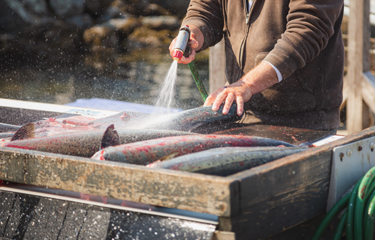Ongoing research being carried out by the National Oceanic and Atmospheric Administration is providing insight into historically poor chinook and chum salmon runs in the U.S. state of Alaska.
The latest research by NOAA is indicating that factors such as poor diet, changes in metabolism, and an increase in parasitic infection among chinook have likely contributed to bad runs on the Yukon and Kuskokwim rivers for the previous two years.
Combined with warmer water temperatures, the effects have been disastrous to salmon and the people who depend on them, according to NOAA. Specifically, scientists have observed that in warm conditions fish typically grow faster and need more food to survive the winter, and fish have been maturing at an earlier age – resulting in them producing fewer eggs.
In the northern Bering Sea, NOAA has been conducting surveys of juvenile chinook and chum salmon of between one and three years of age, for over two decades. During that period, scientists observed a steady decline in abundance of chinook salmon juveniles, though the abundance of juvenile chum has increased in recent years.
While there is a clear relationship between the number of juvenile chinook recorded in those surveys and the number of adults returning to spawn to the Yukon River in future years, the situation isn’t as clear cut for chum.
Scientists are finding that environmental conditions and the availability of prey where chum feed in the ocean in their later years is playing a role in their survivability.
Another factor being studied by NOAA and Alaska Department of Fish and Game (ADFG) scientists is thiamin deficiency in chinook, which has been linked to early mortality, neurological and immune impairment, poor swimming, and an inability to avoid predators.
The ADFG has also seen an increase in parasite infection in salmon returning to the lower Yukon, predominantly in Chinook, resulting in small than average fish.
When looking at how bycatch in Alaska’s commercial groundfish trawl fisheries has affected salmon populations, NOAA scientists found bycatch accounted for less than 3 percent of the total runs to the upper Yukon and Western Alaska river systems in 2020.
Despite evidence mostly linking run declines in 2020 and 2021 to climate-related changes in the marine environment, NOAA said more needs to be done to address salmon bycatch in the face of historically low salmon runs.
The decline of salmon runs in the Yukon and Kuskokwim river systems over the past few years have hit commercial, subsistence, and recreational fisheries considerably.
Hardship in affected communities prompted the U.S. Secretary of Commerce Gina Raimondo to declare fishing disasters there, and in a number of other fisheries in the state, allocating USD 144 million (EUR 137 million) to communities impacted by fishery disasters.
Of that, USD 56 million (EUR 53 million) was directed to the Yukon and Kukokwim, as well Alaska’s Norton Sound, Chignik, Prince William Sound, and Southeast Alaska Salmon Fisheries, according to NOAA.
Photo courtesy of Stephen Bridger/Shutterstock







